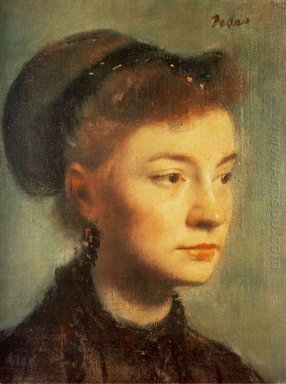The half-length portrait put all the attention of people to focus on a young woman’s face. The artist only saw her shoulder. Her body was a little tilt and three fourths slant to the right. She wore a black dress and seemed to be very serious. Her chestnut hair wore a black velvet ribbon, but the smoothing hair now was probably not very neat previously. Only the lips were painted bright red, and an earring set off the harmony of brown and grayish brown. Edgar Degas was different form his Impressionist friends and he did not treat the black as a color. And impressionist painters almost completely abandoned such tone, and no longer used it to paint the shaded part of landscapes.
When the young Degas created this painting, he chose a fairly thick rough cloth as the canvas. In this way, it was easy for coloring. He put a cloth to be stretched on the canvas frame. Then, he used a precise and accurate action controlled by the depiction and carefully painted. The accurate and free contouring performance performed the uplifted matter and the subtle facial expression.
Degas inherited the great traditions of French portraits since Keluai in the 16th century and had the fine brushwork of the ancient masters (especially Vermeer). He was guided by Ingres who was a prominent person in the 19th century in the treatment of contour and lines. In the process of this Impressionism painting, he painted slowly and began the in-depth thinking. His style changed, as several small bright brushworks lighted the model’s eyes and a few points of the hair. The color of the background was not strong, but very thin. Although some people thought that the portrait depicted Degas’s aunt or cousin in Italy, but it was not sure that the models were them. The model’s sad eyes made her shrouded in a sad and melancholy atmosphere. In 1847, after the death of his mother, the atmosphere had been accompanied by Degas.
